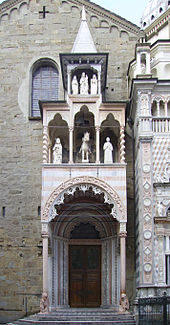Santa Maria Maggiore (Bergamo)
The Roman Catholic Church of Santa Maria Maggiore in Bergamo in Lombardy is a basilica . Construction began in 1137 and remained unfinished. The north transept facade with the vestibule was created around 1350.
Building
The north portal ( Porta dei Leoni rossi ) is covered with an elaborately designed vestibule, dated 1353 and revised in the 14th century. A round arch is supported by two pillars resting on lions made of red Veronese marble. (A pillar on a lion is a symbol for overcoming evil, so it is very common at church entrances. Iconographically , the lions indicate the function of the vestibule as a place of justice .) The archivolt of the round arch depicts a hunting scene. Above the arch there is a loggia with three arcades with pointed cloverleaf arches, in which there are statues of Saints Barnabas, Vincent and Alexander (on horseback). Above them, another loggia covers a Madonna with the child, flanked by the Bergamasque saints Asteria and Grata. The Romanesque portal itself dates from the 12th and 13th centuries.
In front of the south portal ( Porta dei Leoni bianchi ) is a more simply designed vestibule from 1360. The outer pillars rest on white lions; the inner pair of pillars is supported by a male and a female crouching figure.
inner space
The interior is an originally Romanesque (from 1173), later Baroque three-aisled gallery basilica with the monuments and graves of the composers Gaetano Donizetti and Johann Simon Mayr .
organ
The organ of Santa Maria Maggiore was built in 1915 by the organ builder Carlo Vegezzi Bossi, and restored and expanded in 1948 and most recently in 1992 by the organ builders Gebr. Ruffatti. The instrument is set up on the two bleachers in the apse . It can be controlled via a mobile gaming table that is set up in the church near the altar. The organ has 62 stops on three manuals and a pedal . The playing and stop actions are electric.
|
|
|
|
|||||||||||||||||||||||||||||||||||||||||||||||||||||||||||||||||||||||||||||||||||||||||||||||||||||||||||||||||||||||||||||||||||||
Graves of personalities
- Gaetano Donizetti's tomb
- Tomb of Johann Simon Mayr
Web links
- Santa Maria Maggiore basilica . In: visitbergamo.net
- Santa Maria Maggiore basilica . In: in-lombardia.de
Individual evidence
- ^ Lexicon of Christian Iconography (LCI). Freiburg im Breisgau 1968 (1994) IV, p. 225
- ^ Organ (Italian) ( Memento from June 10, 2015 in the Internet Archive )
Coordinates: 45 ° 42 ′ 13.4 " N , 9 ° 39 ′ 43.6" E







